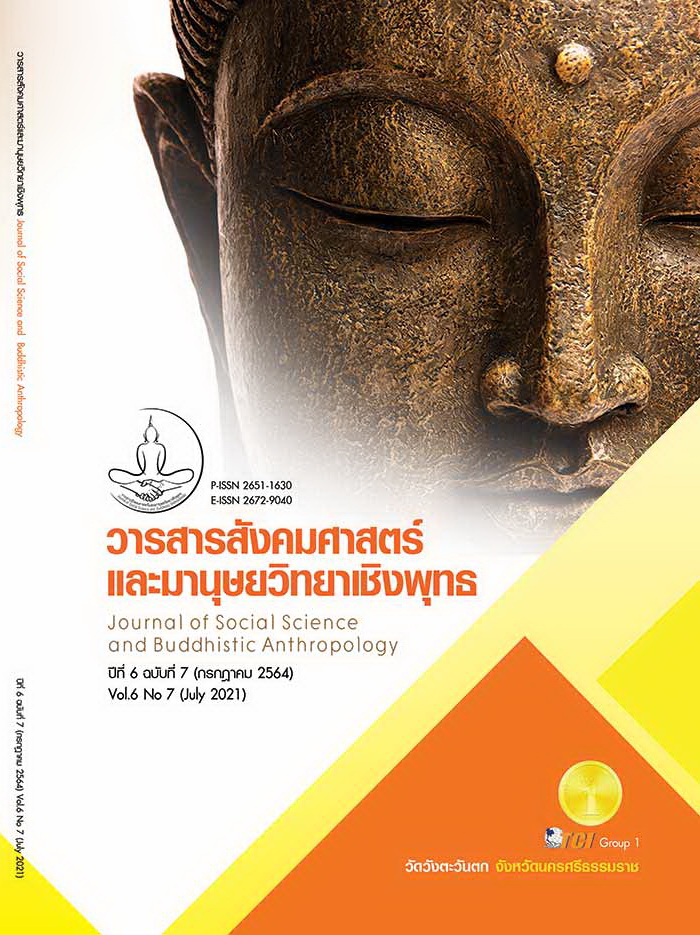A STUDY OF THE CONCEPTUAL FRAMEWORK OF AN ART EDUCATION CURRICULUM BASED ON CONTEMPORARY CONTEXT
Keywords:
Art Education Curriculum, Contemporay Art Education, Curriculum DevelopmentAbstract
The objectives of this research article were to 1) Study and determine the conceptual framework of art education curriculum and contemporary context. 2) Study characteristics of art education curriculum on the stakeholder’s demand. 3) Rank the needs of Art Education curriculum based on contemporary context. The research methodology was mixed the method which comprised of two phases. The first phase of research was qualitative research collecting data by interviewing 19 art education and contemporary context experts. The second phase of research was quantitative research gathering data by questionnaires from 803 curriculum stakeholders. The experts were selected by purposive sampling. The teachers were the entire population. The graduate supervisors and the graduates were selected by the simple random sampling. Qualitative data was analyzed by using thematic framework, coding/indexing, Interpreting and summarizing data reduction techniques. Quantitative data was analyzed by using percentage, means, standard deviation and Modified Priority Needs Index (PNI modified) statistics. The result of 1) The first phase of research indicates that the conceptual framework of art education curriculum should comprise 7 models: 1.1) Art Education Fundamental Theory 1.2) Pedagogy Art Education 1.3) Technology and Innovation Art Education 1.4) Local and Wisdoms Art Education 1.5) Entrepreneurship Art Education 1.6) Personalization Art Education 1.7) Transdisciplinary Art Education. 2) The second phase of research found that the highest desirable condition of the teachers is the Art Education Fundamental Theory. The highest desirable condition of the graduates is the Pedagogy Art Education. The highest desirable condition of the graduate supervisors is the Art Education Fundamental theory. 3) The highest priority needs index of the teachers is the Entrepreneurship Art Education. The highest priority needs index of the graduates is the Technology and Innovation Art Education. The highest priority needs index of the graduate supervisors is the Local and Wisdoms Art Education.
References
ก่อ สวัสดิ์พาณิชย์. (2549). ศิลปศึกษากับการพัฒนาประเทศ. ใน เลิศ อานันทนะ (บรรณาธิการ). แนวคิดเกี่ยวกับศิลปศึกษา. (หน้า 3). กรุงเทพมหานคร: สำนักพิมพ์แห่งจุฬาลงกรณ์มหาวิทยาลัย.
ประสาร มาลากุล ณ อยุธยา. (2549). ศิลปะกับชีวิตประจำวันของเด็ก. ใน เลิศ อานันทนะ (บรรณาธิการ). แนวคิดเกี่ยวกับศิลปศึกษา. (หน้า 27). กรุงเทพมหานคร: สำนักพิมพ์แห่งจุฬาลงกรณ์มหาวิทยาลัย.
ไพฑูรย์ สินลารัตน์. (2559). การศึกษา 4.0 เป็นยิ่งกว่าการศึกษา. กรุงเทพมหานคร: โรงพิมพ์แห่งจุฬาลงกรณ์มหาวิทยาลัย.
มาตรฐานคุณวุฒิระดับปริญญาตรี สาขาครุศาสตร์และสาขาศึกษาศาสตร์ (หลักสูตรสี่ปี) พ.ศ. 2562. (2562). ราชกิจจานุเบกษา เล่ม 136 ตอนพิเศษ 56 ง หน้า 12 (6 มีนาคม 2562).
มารุต พัฒผล. (2562). แนวคิดหลักการพัฒนาหลักสูตร. กรุงเทพมหานคร: ศูนย์ผู้นำนวัตกรรมหลักสูตรและการเรียนรู้.
วรากรณ์ สามโกเศศ. (2560). edtech เปลี่ยนแปลงโลกการเรียนรู้. เรียกใช้เมื่อ 1 มิถุนายน 2561 จาก http://www.bangkokbiznews.com/blog/detail/642050
สันติ คุณประเสริฐ. (2547). การเรียนการสอนศิลปศึกษาตามแนว Postmodernism. ใน ปุณณรัตน์ พิชญไพบูลย์ (บรรณาธิการ). ศิลปศึกษา จากทฤษฎีสู่การสร้างสรรค์. (หน้า 60). กรุงเทพมหานคร: สำนักพิมพ์แห่งจุฬาลงกรณ์มหาวิทยาลัย.
สํานักงานคณะกรรมการนโยบายวิทยาศาสตร์ เทคโนโลยี และนวัตกรรมแห่งชาติ. (2555). นโยบายและแผนวิทยาศาสตร์ เทคโนโลยีและนวัตกรรมแห่งชาติ ฉบับที่ 1 (พ.ศ. 2555 - 2564). กรุงเทพมหานคร: กระทรวงวิทยาศาสตร์และเทคโนโลยี.
สำนักงานคณะกรรมการพัฒนาการเศรษฐกิจและสังคมแห่งชาติ. (2560). ยุทธศาสตร์ชาติ พ.ศ. 2561 - 2580. กรุงเทพมหานคร: สำนักงานเลขานุการของคณะกรรมการยุทธศาสตร์ชาติ.
สำนักงานคณะกรรมการพัฒนาเศรษฐกิจและสังคมแห่งชาติ. (2560). แผนพัฒนาเศรษฐกิจและสังคมแห่งชาติฉบับที่ 12 (พ.ศ. 2560 - 2564). กรุงเทพมหานคร: สำนักงานคณะกรรมการพัฒนาการเศรษฐกิจและสังคมแห่งชาติ.
สำนักงานนวัตกรรมแห่งชาติ. (2562). Toward Innovation Nation. กรุงเทพมหานคร: บริษัท พิมพ์ดี จำกัด.
สำนักงานเลขาธิการสภาการศึกษา. (2560). แผนการศึกษาแห่งชาติ พ.ศ. 2560 - 2579. กรุงเทพมหานคร: สำนักงานเลขาธิการสภาการศึกษา.
สิรินทร์ ลัดดากลม บุญเชิดชู. (2558). STEM to STEAM Plus STREAM and STEMM. วารสารศึกษาศาสตร์ มหาวิทยาลัยศิลปากร, 13(1), 6-16.
ออมสิน จตุพร และอมรรัตน วัฒนาธร. (2557). หลักสูตรท้องถิ่น: วาทกรรมว่าด้วย “หลักสูตร” และแนวโน้มการวิจัยด้านหลักสูตรจากมุมมองเชิงวิพากษ์และหลังสมัยใหม่นิยม. วารสารศึกษาศาสตร์ มหาวิทยาลัยนเรศวร, 16(3), 200- 213.
Demarest, A. B. (2015). Placed-based Curriculum Design. New York: Routledge.
Freedman, K. (2003). Teaching Visual Culture. New York: Teacher College Press.
Hamre, H. J. et al. . (2007). Anthroposophic Art Therapy in Chronic Disease: A Four-Year Prospective Cohort Study. EXPLORE The Journal of Science and Healing, 3(4), 365-371.
Khazanie, R. (1996). Statistics in a World of Applications. (4th ed.). New York: Harper Collins.
Krejcie, R. V. & Morgan, D. W. (1970). Determining Sample Sizes for Research Activities. Educational and Psychological Measurement, 30(3), 607-610.
The Partnership for 21st Century Skills. (2011). Framework for 21st Century Learning. Washington, DC: P21. Retrieved April 30, 2016, from http://www.p21.org/our-work/p21-framework_flyer_updated_april_2009.pdf
UNESCO. (2006). Road Map for Arts Education. Lisbon: UNESCO.
World Economic Forum. (2018). The Global Risks Report 2018 13th Edition. Geneva: World Economic Forum.








